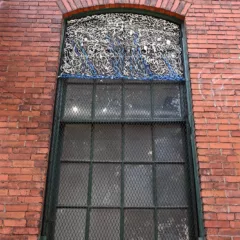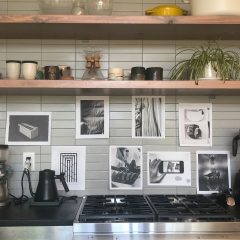If you run into me in public at any given time, chances are high that I’ll be distractedly thinking about daily needs and tasks. When we part company, it’s likely that I won’t later recall what color shirt you were wearing, or whether your hair was a bit mussed up in the back. What I will remember is the words exchanged, the tone of our chat and your friendly smile. I suspect that I am not the only person to experience this phenomenon. Brian Fernandes-Halloran’s show at MUSE Gallery, close by, confirms my suspicion that this is a common occurrence. He asks us to reflect on the way we interact with others.
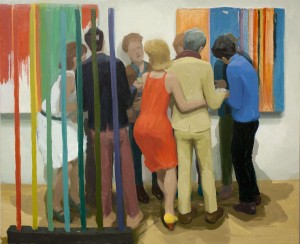
Fernandes-Halloran’s bright paintings line the long walls of the space. Each is softly rendered and depicts tableaus from daily life. Two sculptural pieces round out the show and balance the two dimensional works. A poem on the wall entitled, “are we close?” asks, “when are we neighbors? when we are polite? when we glance at each other in passing?…” I was glad to have read the poem first as it set the tone for the show and it instantly had me thinking about my interactions with others. I also liked that the gallery’s lean space echoed the personal/ intimate conceptual qualities of the work.
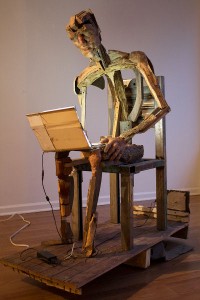
“browser” is composed of found objects and wax and greets the viewer upon entry. A man is perched on a chair and peers into a glowing laptop. Rough wood scraps comprise the subject’s body. Construction of the piece is haphazard, and I noticed that the man is missing feet. In an interesting textural juxtaposition, the subject’s shoulders, face and hands are gracefully formed with wax. The piece had a definitive air of speed suggesting that our virtual interactions are somewhat slapdash. I must admit, I stopped using a certain social networking site a few years back and I’ve noticed a return to formality in my e-mails and wonder whether all that instant communication is beneficial to the way in which we relate.
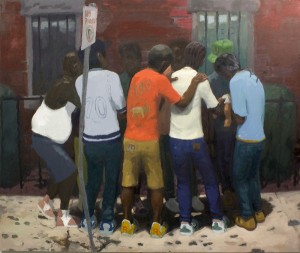
I have a natural curiosity in people and Fernandes-Halloran seems to share this interest. “introducing his baby” is tender; a group of men huddle together on the sidewalk, engaged in conversation around a man holding his newborn child. It seems that this scene was recalled from Fernandes-Halloran’s memory. The body language of these men is deceptive—at first glance I thought they might have been fighting or arguing. Two men have their arms around each other and they appear to be animated. The man who holds the baby is positioned towards the back of the group, the baby’s plump legs are barely in view. It’s always interesting to observe a warm interaction from afar and be reminded of man’s capacity for love and joy.
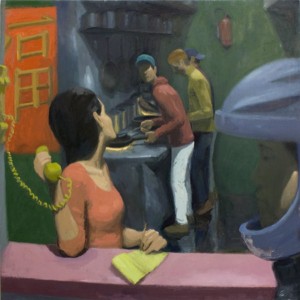
One choice I found interesting was that Fernandes-Halloran does not always fully render the faces of the subjects in these paintings. “chinese takeout” places the viewer in line at a restaurant waiting for a take-away order. The faces of the employees in the kitchen vary in degrees of specificity. “pretty viewer” is a close-up of a woman who appears to be attractive, but her face is blank (as in, there are no features). Here I thought about my own memories of passing conversations and brief interactions with strangers whose faces I only partially recall.
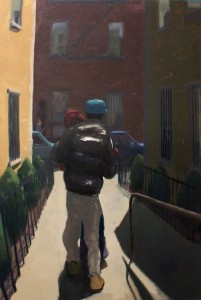
Fernandes-Halloran is toying with memory and examining how much (or sometimes how little) he recalls from social interactions. I get the distinct feeling that he wishes he remembers more from these moments; his paintings all have a warm tone that accents this conceptual theme. The works are very honest and relatable—humans are social animals and we crave contact with others. I felt that Fernandes-Halloran was suggesting that we could do better in making ourselves be more aware of the way we relate to others. This show caused me to reflect about how “present” I am in conversation and how mindful I am of the ways our lives intersect.
close by was MUSE Gallery until January 26. More information can be found by visiting their website. For more information about the artist, please visit his website. All images are courtesy of the artist.



